Time-Series Properties
Chaos and Time-Series Analysis
10/31/00 Lecture #9 in Physics 505
 Comments on Homework
#7 (Poincaré Sections)
Comments on Homework
#7 (Poincaré Sections)
-
Some people's Poincaré sections were obviously not correct
-
Increasing the damping generally decreases the attractor dimension, eventually
leading to a limit cycle.
-
Sample results for 0 < b < 0.4
 Review (last
week) - Hamiltonian Chaos
Review (last
week) - Hamiltonian Chaos
-
Properties of Hamiltonian (Conservative) Systems
-
They have no dissipation (frictionless)
-
There are one or more (k) conserved quantities (energy, ...)
-
They are described by a Hamiltonian function H
whose partial derivatives d
gives the dynamical equations:
-
dx/dt = dH/dv
-
dv/dt = -dH/dx
-
There are 2N dimensions for N degrees of freedom
-
Motion is on a 2N - k dimensional (hyper)surface
-
k + 1 Lyapunov exponents are equal to zero
-
There are no attractors (or attractor = basin)
-
Transients don't die away (no need to wait)
-
Equations are time-reversible
-
Trajectory returns arbitrarily close to the initial condition
-
Phase-space volume is conserved (Liouville's theorem)
-
The flow is incompressible (like water)
-
The Lyapunov exponents sum to zero
-
Chaos can occur only for N > 1 (at least 2 degrees
of freedom)
-
The dynamics occur in a space of integer dimension
-
This space may be a (fat) fractal however (infinitely many holes)
-
Example - Chirikov (Standard) Map
-
rn+1 = [rn - (K/2p)
sin(2pqn)] (mod 1)
-
qn+1 = [qn
+ rn+1] (mod 1)
-
K is the nonlinearity parameter
-
This system also models ball bouncing on vibrating floor
-
Animation of Chirikov
map
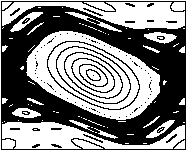
-
Example - Simplest conservative chaotic flow
-
dx/dt = y
-
dy/dt = z
-
dz/dt = x2 - y - B
-
For B less than about 0.05
-
Poincaré section for B =
0.01
 Time-Series Analysis
- Introduction
Time-Series Analysis
- Introduction
-
This is the second major part of the course
-
Previously shown: simple equations often have complex behavior
-
This suggests: complex behavior may have a simple cause
-
We move from a theoretical to an experimental viewpoint
-
Applications of time-series analysis:
-
Prediction, forecasting (economy, weather, gambling)
-
Noise reduction, encryption (communications, espionage)
-
Insight, understanding, control (butterfly effect)
-
Time-series analysis is not new
-
Some things are new:
-
Better understanding of nonlinear dynamics
-
New analysis techniques
-
Better and more plentiful computers
-
Precautions:
-
Time-series analysis is more art than science
-
There are few sure-fire methods
-
We generally need a battery of tests
-
It's easy to fool yourself
-
The literature is full of false claims of chaos
-
New algorithms are constantly being developed
-
"Is is chaos?" might not be the right question
 Hierarchy of Dynamical
Behavior
Hierarchy of Dynamical
Behavior
(adapted from F. C. Moon)
-
Regular predictable behavior (planets, clocks, tides)
-
Regular unpredictable behavior (tossing a coin)
-
Transient chaos (pinball machine)
-
Intermittent chaos (logistic equation)
-
Narrow-band (almost periodic) chaos (Rössler attractor)
-
Broad-band low-dimensional chaos (Lorenz attractor)
-
Broad-band high-dimensional chaos (Mackey-Glass system)
-
Correlated (colored) noise (random walk)
-
Pseudo-randomness (computer RND function)
-
Random (non-deterministic) white noise (radio static)
-
Superposition of several of the above (weather, stock market)
 Examples of Experimental
Time Series
Examples of Experimental
Time Series
-
Xn iterates from an iterated map (i.e., logistic
equation)
-
x(t) sampled at regular intervals for flow (i.e.,
Lorenz attractor)
-
Population growth (plants, animals)
-
Meteorological data (temperature, etc.)
-
El Niño (Pacific ocean temperature)
-
Seismic waves (earthquakes)
-
Tidal levels (good example of N-torus)
-
Astrophysical data (sunspots, Cephids, etc.)
-
Fluid fluctuations / turbulence (plasmas)
-
Financial data (stock market, etc.)
-
Physiological data (EEG, EKG, etc.)
-
Epidemiological data (diseases)
-
Music and speech
-
Geological core samples
-
Sequence of ASCII codes (written text)
-
Sequence of bases in DNA molecule
-
Many others ...
-
Center of mass of standing human
-
Interval between footsteps
-
Reaction time intervals
-
Necker cube flips

-
Eye movements
-
Human metronome (tap your foot)
-
Attempted human randomness
-
Imitate radioactive decay (Geiger counter)
-
Write a list of "random numbers"
-
Generate a random sequence of bits (0, 1)
-
Click mouse at random points on a line
or in a circle or within a square
-
The independent variable may not be time, but space, frequency,
...
 Practical Considerations
Practical Considerations
-
You may not know the dynamical variables
(or even how many of them there are)
-
You may not have experimental access to them
-
You may only have a short time record
-
The record is usually sampled at discrete times
-
The sample rate may not be chosen optimally
-
The sample time may be non-uniform
(or some data samples may be missing)
-
The data are subject of measuring and rounding errors
-
The system may be contaminated by noise
-
The signal may be filtered by the detector
-
The system may not be stationary (bull market)
 Case Study
Case Study
-
Two similar signals (one random,
one chaotic)
-
Random signal (Gaussian white noise)
-
Add N pseudorandom numbers uniform in 0 to 1
(called "uniform deviates")
-
Subtract their average (N/2)
-
For large N, the result is a Gaussian (normal) distribution
with a standard deviation of (N/6)1/2

-
For many purposes N = 6 suffices, but maximum value is only 3.
-
Chaotic signal (logit transform of logistic map)
-
Generate sequence of iterates from Xn+1
= 4Xn(1 - Xn)
-
Transform each iterate by loge[X/(1 - X)]
-
Result approximates a Gaussian distribution

-
But it is obviously chaotic (1-dimensional)
(since it came from the logistic map)
-
Conventional linear analysis
-
Assume signal is sum of sine waves (Fourier modes)
-
Example: looking for "cycles" in stock prices
-
Look at power spectrum P(f)
-
Highest f is Nyquist frequency: fmax
= 1/2Dt
(Dt is the time interval between
data samples)
-
If Dt is too large, aliasing can
occur
-
Lowest f is approximately: fmin = 1/NDt
(N is the number of data points)
-
If N is too small, data may not be stationary
-
White noise has P(f) = constant
-
Chaos (i.e., logistic map) can also have
P(f)
= constant
-
Hence, this is a bad method for detecting chaos
-
It works well for limit cycles (like van
der Pol case)
and for N-torus (2 sine
waves or 3 sine waves, etc.)
which can be hard to distinguish
from chaos
-
Instead, look at the return maps
(Xn+1 versus Xn)
 Autocorrelation Function
Autocorrelation Function
-
Calculating power spectrum is difficult
(Use canned FFT or MEM - see Numerical
Recipes)
-
Autocorrelation function is easier and equivalent
-
Autocorrelation function is Fourier transform of power spectrum
-
Let g(t) = <x(t)x(t+t)>
(< ... > denotes time average)
-
Note: g(0) = <x(t)2> is
the mean-square value of x
-
Normalize: g(t) = <x(t)x(t-t)>
/ <x(t)2>
-
For discrete data: g(n) = S
XiXi+n
/ S Xi2
-
Two problems:
-
i + n cannot exceed N (number of data points)
-
Spurious correlation if Xav = <X> is
not zero
-
Use: g(n) = S (Xi
- Xav)(Xi+n - Xav)
/ S (Xi - Xav)2
-
Do the sums above from i = 1 to N - n
-
Examples (data records of 2000 points):
-
Gaussian white noise:
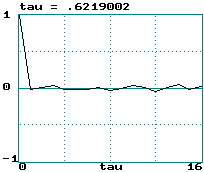
-
Logit transform of logistic equation:
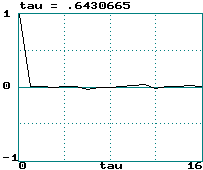
-
Hénon map:
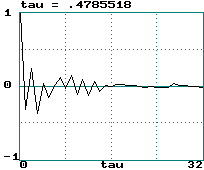
-
Sine wave:
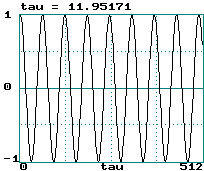
-
Lorenz attractor (x variable step size 0.05):
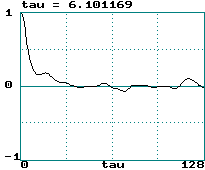
-
A broad power spectrum gives a narrow correlation function
and vice versa
-
Colored (correlated) noise is indistinguishable
from chaos
-
Correlation time is width of g(t)
function (call it tau)
-
It's hard to define a unique value of this width
-
This curve is really symmetric about tau = 0 (hence width is 2 tau)
-
0.5/tau is sometimes called a "poor-man's Lyapunov exponent"
-
Noise: LE = infinity ==> tau = 0
-
Logistic map: LE = loge(2) ==> tau
= 0.72
-
Hénon map: LE = 0.418 ==> tau = 1.20
-
Sine wave: LE = 0 ==> tau = infinity
-
Lorenz attractor: LE = 1.50/sec = 0.075/step ==>
tau = 6.67
-
This really only works for tau > 1
-
Testing this would make a good student project
-
The correlation time is a measure of how much "memory" the
system has
-
From the correlation function g(n), the power spectrumP(f)
can be found:
P(f) = 2 S g(n)
cos(2pfnDt)
Dt
(ref: Tsonis)
 Time-Delayed Embeddings
Time-Delayed Embeddings
-
How do you know what variable to measure in an experiment?
-
How many variables do you have to measure?
-
The wonderful answer is that (usually) it doesn't matter!
-
Example (Lorenz attractor):
-
Plot of y versus x:
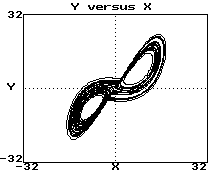
-
Plot of dx/dt versus x:
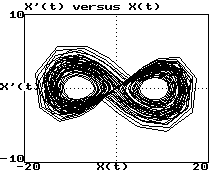
-
Plot of x(t) versus x(t-0.1):
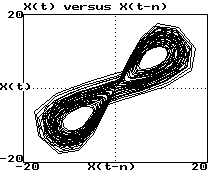
-
These look like 3 views of the same object
-
They are "diffeomorphisms"
-
They have same topological properties (dimension, etc.)
-
Whitney's embedding theorem says this result is general
-
Taken's has shown that DE = 2m
+ 1
-
m is the smallest dimension that contains the attractor
(3 for Lorenz)
-
DE is the maximum time-delay embedding
dimension (7 for Lorenz)
-
This guarantees a smooth embedding (no intersections)
-
This is the price we pay for choosing an arbitrary variable
-
Removal of all intersections may be unnecessary
-
Recent work has shown that 2m may be sufficient (6 for Lorenz)
-
In practice m often seems to suffice
-
Example (Hénon viewed in various ways):
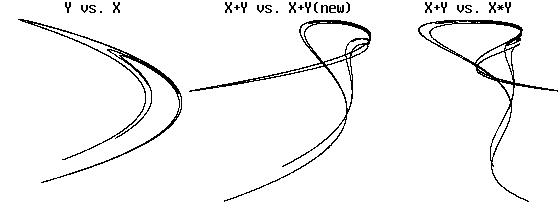
There is obvious folding, but topology is preserved
-
How do we choose an appropriate DE (embedding
dimension)?
-
Increase DE until topology of attractor (dimension) stops
changing
-
This may require more data than you have to do properly
-
Saturation of attractor dimension is usually not excellent
-
Example: 3-torus (attractor
dimension versus DE , 1000 points)
-
Can also use the method of false nearest neighbors:
-
Find the nearest neighbor to each point in embedding DE
-
Increase DE by 1 and see how many former nearest neighbors
are no longer nearest
-
When the fraction of these false neighbors falls to nearly zero, we have
found the correct embedding
-
How do we choose an appropriate Dt
for sampling a flow?
-
In principle, it should not matter
-
In practice there is an optimum
-
Rule of thumb: Dt ~ tau / DE
-
Vary Dt until tau is about DE
(3 to 7 for Lorenz)
-
A better method is to use minimum mutual information
J. C. Sprott | Physics 505
Home Page | Previous Lecture | Next
Lecture












